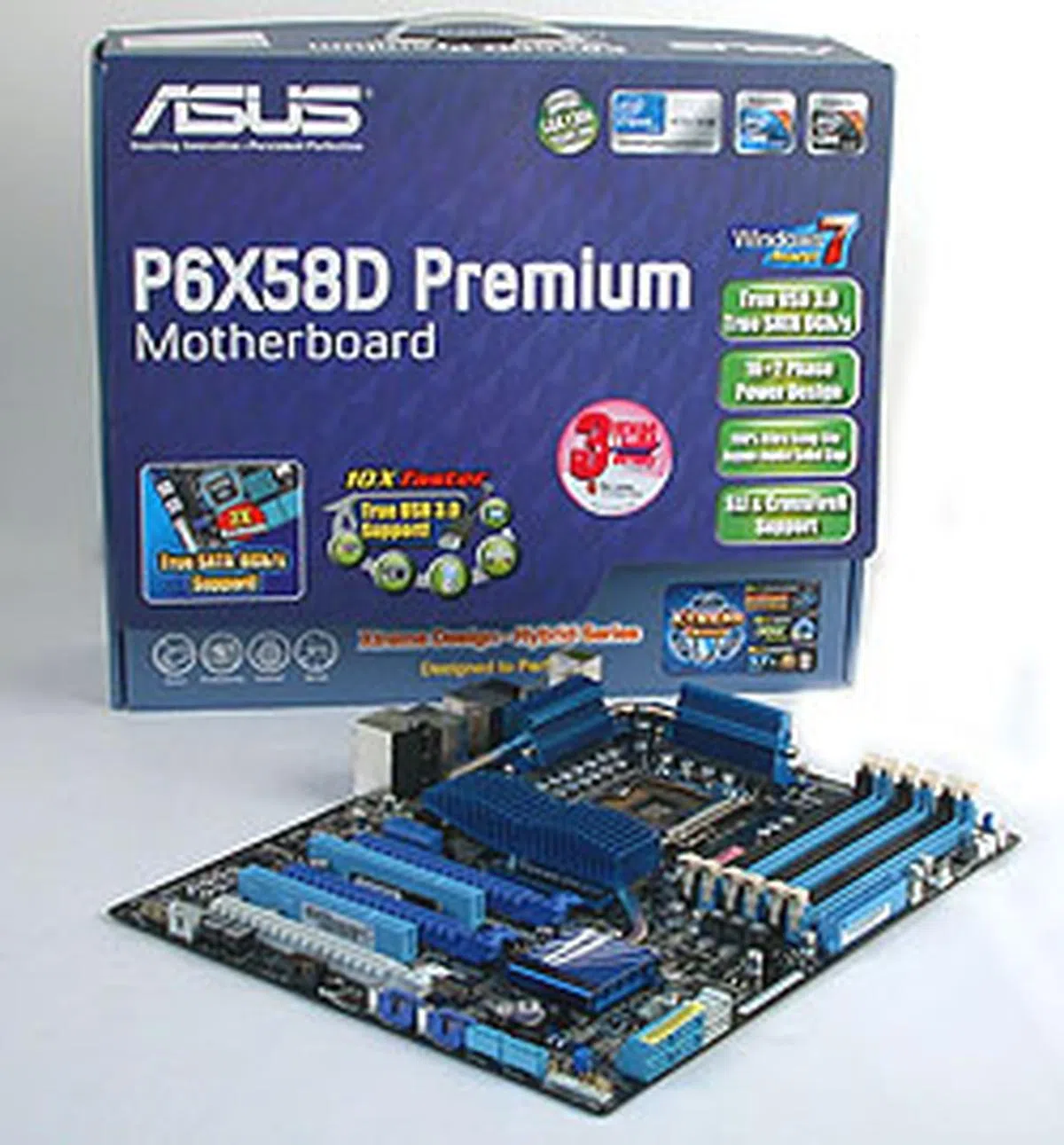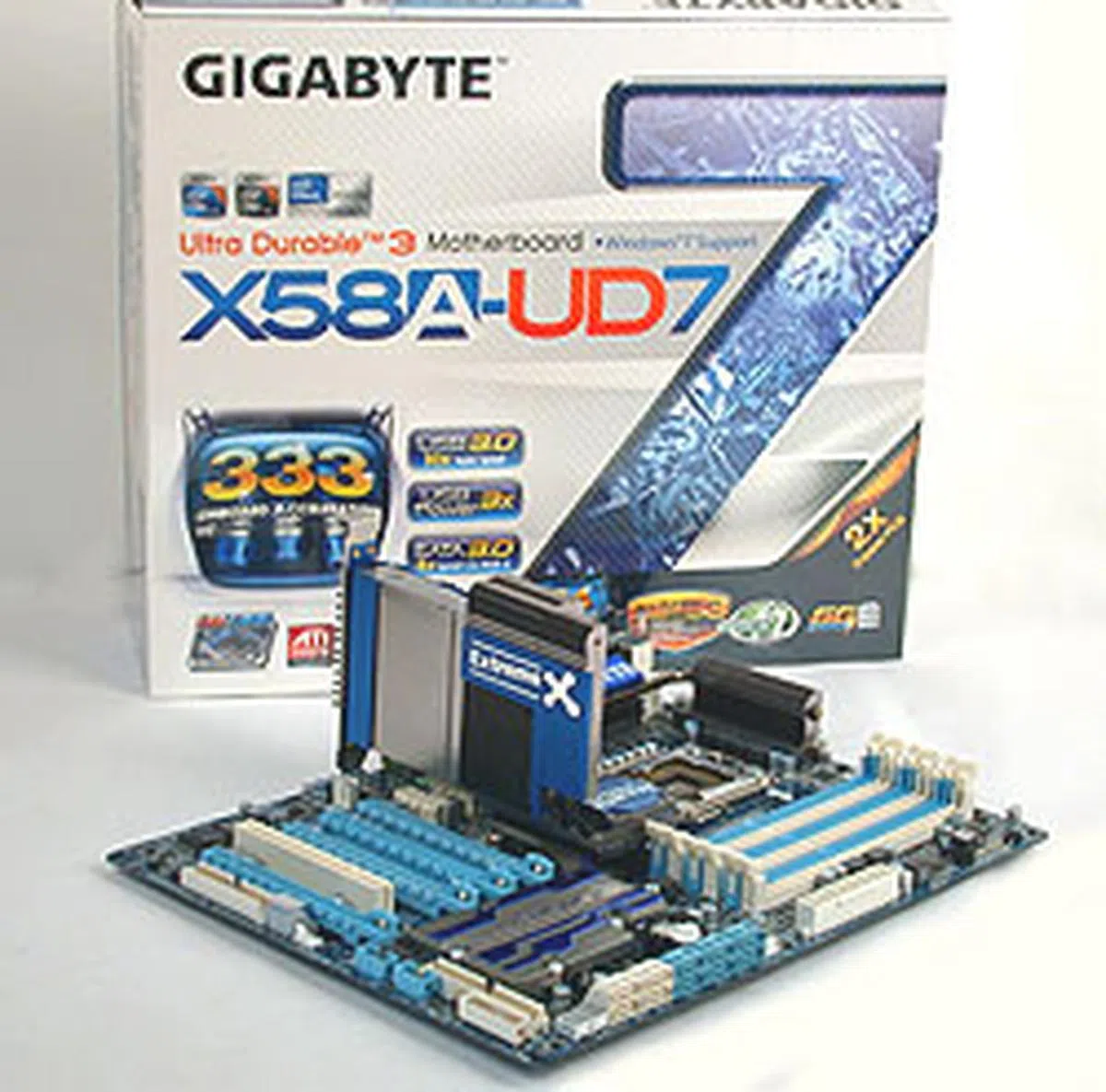Return of the X58 - The Best from ASUS and Gigabyte
With the launch of the first 6-core processor, the Intel Core i7-980X, the spotlight is back on Intel's X58 Express chipset. What's different this time round is that vendors have updated the chipset with features comparable to newer ones like that on the Intel P55. We return to the X58 scene with two top boards from ASUS and Gigabyte and the Core i7-980X.
Return of the King
The arrival of Intel's first 6-core processor, the Core i7-980X, has renewed interest in a chipset that is largely forgotten with the wave of more affordable P55 motherboards. Despite being Intel's premier chipset for the Core i7, the X58 Express chipset was always going to be a niche product due to the cost, especially once you factor in the processor and the relatively high price of triple-channel DDR3 memory then.
As the only Socket LGA1366 chipset from Intel however, those looking to upgrade to the first 32nm Gulftown 6-core processor are restricted to an Intel X58 motherboard. Fortunately, these motherboards, most of which have been available for more than a year, will support the Core i7-980X with just a BIOS update. And some vendors have also upgraded their high-end models with the latest features, like SATA 6Gbit/s and USB 3.0, making them competitive with market alternatives.
Today, we examine two of these updated Intel X58 motherboards from major vendors, ASUS and Gigabyte. Each of them represents the highest end product from these companies and they have spared no expense in outfitting them with some of their top features and technologies. We have hence equipped them with appropriately enthusiast level components during our testing, including the 6-core Core i7-980X and a Radeon HD 5870 graphics card, the better to showcase the performance you'll find on these boards.

Our two refreshed X58 contenders, the ASUS P6X58D Premium and Gigabyte GA-X58A-UD7.
ASUS P6X58D Premium | Gigabyte X58A-UD7 | |
CPU Support | Support for Socket LGA1366 Core i7 processors | |
Chipset | Intel X58 and ICH10R | |
Graphics | Supports NVIDIA 3-way SLI and ATI Quad-GPU CrossFireX | Support for 3-way ATI CrossFire and 3-way NVIDIA SLI |
Memory |
|
|
Storage |
|
|
Audio | Realtek ALC889 HD CODEC | Realtek ALC889 HD CODEC |
Networking | 2 x Marvell 88E8056 PCIe Gigabit LAN controllers | 2 x Realtek RTL8111D Gigabit LAN controllers |
IEEE 1394 (FireWire) |
|
|
I/O Interface |
|
|
Internal Connectors |
|
|
Expansion Slots |
|
|
Special Features |
|
|
PCB | ATX Form Factor (30.5 x 24.4cm)
| ATX Form Factor (30.5 x 24.4cm) |
The ASUS P6X58D Premium
Despite having features that would classify it as a premium product, the ASUS P6X58D Premium does not belong to the vendor's enthusiast oriented Republic of Gamers family. But there's no denying that the P6X58D will easily stand among the top boards in ASUS' lineup just due to the sheer number of features. For one, it has the updated SATA 6Gbps and USB 3.0 features that older X58 boards lacked. It's a typical implementation, with ASUS opting for the basic Marvell SATA 6Gbit/s controller (with no additional SATA support) and the standard NEC USB 3.0 controller.
There's no issue with bandwidth on the X58 chipset and as such we don't find the bridge chip that ASUS implemented on its P55 version to ensure sufficient bandwidth for the SATA 6Gbps feature. One does find the older ICH10R Southbridge on this board, in keeping with Intel's reference design. This Southbridge provides most of the SATA ports - six SATA 3Gbps versions that are situated at the edge of the board. There are however only two SATA 6Gbps ports available (in gray).
As befits a board of its class, ASUS ticks all the right checkboxes when it comes to features. There's FireWire support and dual Gigabit Ethernet ports. There's a HD audio CODEC with optical and coaxial outputs. A heat-pipe enhanced cooling solution that's not too intrusive. Notable too are the ones that are missing - older interfaces like IDE and floppy.

ASUS' recent blue streak continues with the P6X58D Premium, which comes in a few shades of blue.

Surprisingly, the rear panel wasn't as crowded as we expected. There's a good mix of various ports, from the S/PDIF outputs to a FireWire port. There's also a small, black Clear CMOS button.

Due to space constraints, two of the SATA 3.0Gbps ports are shunted at the side with the front panel. Fortunately, it's still at the board's edge. The gray SATA ports are the SATA 6Gbit/s versions.

The standard six DIMM slots on an X58 motherboard.

A closer look reveals that location of ASUS' MemOK! feature and near that, a blue jumper that can extend the maximum limit on voltages in the BIOS when enabled.
It's not just about the features however, as ASUS did a good job of ensuring that the layout was not neglected. The vendor hardly made a wrong step as we encountered no issues during our testing. From the unique ASUS retention mechanism on the PCIe x16 slots to the ample space between these slots and the edge-facing SATA ports, the layout was very well-done. Of course, it helped that this board's lack of IDE and floppy connectors freed up some PCB space.

ASUS has not been too ambitious with the number of expansion slots. Three PCIe 2.0 x16 slots enable 3-way SLI/CrossFireX comfortably with dual-slot cards. They come with ASUS' unique bracket retention clips that are designed for easy removal of installed cards. Buried among the slots is ASUS' Express Gate module.

Every slot looks usable, even this PCIe x1 that's right next to the heatsink.

The socket area is relatively clean, surrounded by low-profile heatsinks linked by heat-pipes. Power to the CPU is regulated by what ASUS calls its Xtreme Phase (16 + 2) power phase design.
Besides the features mentioned, a host of ASUS' proprietary technologies are found on this board, from the Xtreme phase design, a 16-phase power design to ASUS' long-standing Express Gate. There are tools for overclocking, like TurboV and tools for stability, like the memory compatibility MemOK!. Practically all of these technologies have been seen in other ASUS motherboards previously. It's quite an extensive list and not everyone of them will be used, but there's sufficient variety that one will use at least one, especially our favorite BIOS flashing tool.
The Gigabyte GA-X58A-UD7
For a while now, Gigabyte's high-end boards have been quite predictable. Stack on the storage options, keeping older interfaces like IDE and floppy while reinforcing the stability with ever more aggressive power delivery design. It certainly makes for a very solid, and hefty board, thanks to Gigabyte's Ultra Durable feature. The UD7 here today continues this trend with a design that's little different from the Gigabyte EX58-EXTREME that made its debut in 2008.
In fact, one can argue that the two are identical, with Gigabyte updating to SATA 6Gbit/s and USB 3.0 for the newer UD7. Even the layout is mostly similar as like the EXTREME, the UD7 is quite crowded. There's no wasted PCB space as Gigabyte cannot afford that. First, let's talk about the massive storage options. Besides the ICH10R Southbridge and its six SATA 3Gbps ports, Gigabyte has included a Marvell controller for two SATA 6Gbps ports. This controller is a slightly superior version to the one found on ASUS, as it comes with SATA RAID support.
Then, there's Gigabyte own SATA2 chip, which adds two more SATA 3Gbps ports, along with IDE support for two devices. A JMicron controller gives eSATA/USB functionality at the rear panel, despite the presence of USB 3.0 ports. And then we get to the floppy drive controller to cover all the storage options. As you can see, this formula is no different from the various storage-heavy boards from Gigabyte in recent times. Even its mid-range products have comprehensive storage options.

Those who have seen Gigabyte's older X58 board, the EX58-EXTREME, will find more of the same with the UD7. Except for the upgraded features of course.

The Clear CMOS button here is really a bit larger than we deem safe. Gigabyte has included quite a generous number of ports, even eSATA/USB combo ports along with the USB 3.0 ones (blue).

As usual, Gigabyte heavily focuses on the storage department. Look at the sheer number of SATA ports included. Not to mention the IDE and floppy ports.

The triple-channel DIMMs and the power button. Right next to the power button is the much smaller, blue reset switch.
Another feature that's distinctive of the EX58-EXTREME is the Hybrid Silent-Pipe 2, a separate add-on heatsink card that acts as a giant radiator. Heat-pipes convey the excess heat from the board to this heatsink where it will be eventually vented out of the system. We did not test the efficacy of this heatsink, as our usual testing routine does not exactly require such cooling prowess. If you don't need such an extensive cooling solution, we recommend that you skip this board, as this radiator will no doubt add to the cost of this motherboard.

Like the EX58-EXTREME, Gigabyte has included a huge heatsink that takes up one expansion slot for those who are into more extreme cooling, also known as Hybrid Silent-Pipe 2.

As mentioned, IDE is alive and kicking on this board, along with a floppy connector.
The number of features and connectors however lead to one of our usual complaints about Gigabyte's boards. It's not a serious issue but quite often, the layout only works for certain connectors. In this case, there are four PCIe graphics slots but effectively, one cannot setup quad-GPU due to the limitations of the PCIe lanes. Not only that, with three of them in close proximity, the typically, more powerful, dual-slot graphics cards would not be able to fit anyway.
A similar issue affects the PCIe x1 slots, which is so restricted by the heatsink that we're not sure what kind of card Gigabyte is expecting users to install. Fortunately, the rest of the board gave us no reasons to complain, though the large CMOS button at the rear panel is potential cause for concern for the careless user.

There may seem like four PCIe 2.0 x16 slots but not all are capable of doing x16/x16. Some are in fact running at x8. They are also clustered rather closely, such that dual-slot graphics cards would effectively make it a 3-way configuration at best.

These two expansion slots are just as good as occupied, especially if you're using the Hybrid Silent-Pipe 2.

The socket area of this board is dotted by numerous capacitors and ferrite core based chokes, as one would expect from a board claiming a 24-phase power design.
Of course, Gigabyte has its own list of in-house technologies, all of which should be familar to enthusiasts, as they have been present for a while now. From the company's well-known Ultra Durable 3 to newer additions like 3X power delivery for USB devices, these technologies all play their part in ensuring enthusiasts have all the tools they need to fiddle around. Just like the ASUS however, it's the stalwarts that we end up using most of the time, like Q-Flash for updating the BIOS and the dual BIOS feature.
BIOS Settings
As one may expect from premium, enthusiast-class boards like these, ASUS and Gigabyte come with extensive BIOS settings, more than the essential ones that we have listed below. So the compulsive tweaker will find much to like about these boards. We only managed to push the base clocks for the two boards to 220MHz, which is similar to previously tested X58 boards.
O/C Settings | ASUS P6X58D Premium | Gigabyte X58A-UD7 |
Base Clock (MHz) | 100 - 500 | 100 - 600 |
CPU Ratio | 12 - 63 | 12 - 65 |
DRAM Frequency | Auto, 800, 1066, 1333, 1600, 1866, 2133, 2400 | 800, 1066, 1333, 1600, 1867, 2133, 2400 |
Voltage Adjustments |
|
|
Tested Overclock Settings | Base Clock: 220MHz max | Base Clock: 220MHz max |
Test Setup
As we mentioned earlier, our goal was to accompany these high-end X58 motherboards with equally high-end components and to that end, we have included some of the latest hardware available. This means having a SATA 6Gbps hard drive, a Radeon HD 5870 graphics card and Windows 7 Ultimate among other things. Besides the two boards, a Gigabyte EX58-EXTREME is used as a baseline comparison. This is an older X58 board that doesn't get the SATA 6Gbps and USB 3.0 treatment, but it does have the latest BIOS and we don't expect the hard drive to make that much of a difference.
- Intel Core i7-980X (@3.33GHz, Intel Turbo Boost, HyperThreading enabled)
- 3 x 1GB Kingston HyperX DDR3-1333 @ 7-7-20 CAS 7.0
- Seagate Barracuda XT 2TB SATA 6Gbit/s hard disk drive (one single NTFS partition)
- ATI Radeon HD 5870 1GB (Catalyst 10.2)
- Intel INF 9.1.1.1025 and Intel Matrix Storage manager 8.9.0.1023 driver set
- Microsoft Windows 7 Ultimate
The following benchmarks were used:
- BAPco SYSmark 2007 (version 1.05)
- Futuremark PCMark Vantage (1.0.3.1)
- Futuremark 3DMark Vantage (1.0.3.1)
- SpecView Perf 9.0
- Far Cry 2
- World in Conflict
- Crysis Warhead
Results - SYSmark 2007 Preview
The first benchmark, SYSmark 2007 had the newer Gigabyte board springing off to a good start. It edged ahead of the ASUS and the reference Gigabyte EX58-EXTREME by some distance. Its main strength however appeared to be in the Productivity segment, where it pulled away from the competition.


Results - Futuremark PCMark Vantage
It was a close outcome in the other system test suite, as the ASUS P6X58D Premium took a narrow lead over the Gigabyte GA-X58A-UD7. The reference Gigabyte board finshed third overall, though the difference was not as pronounced as the scores would suggest. With the exception of the Memories and HDD segments, all the boards were quite comparable. For those two segments, ASUS was clearly the better board, particularly for the HDD segment.





Results - SPECviewperf 9.0
While all three boards were similar in 3dsmax, the PRO/ENGINEER segment in SPECviewperf 9.0 saw the two newer X58 boards justifying their upgraded status by beating the Gigabyte EX58-EXTREME by a fair amount.


Results - Futuremark 3DMark Vantage
Surprisingly, we found the Gigabyte X58A-UD7 to finish slightly slower than the other boards here. Despite repeated tests, the results were identical and we found that the CPU portion of 3DMark Vantage for the Gigabyte UD7 was lower than usual.

Results - Gaming Benchmarks
These gaming benchmarks allowed us to fully stretch these boards, as we ramped up the resolutions and settings. Crysis Warhead for example, really pushed these systems to their limits, as all three barely managed an average of 30fps - which still pinned the mighty Radeon HD 5870 as the bottlneck. A glance through the results showed identical scores for all.



Temperature
For the temperature section, we measured the temperature of the passive heatsink placed over the chipset die with a laser thermometer after subjecting the systems to an endless loop of 3DMark06. The ASUS was easily the coolest of the three here, with a reading that was more than 10 degrees Celsius lower than the Gigabyte UD7.

Power Consumption
However, when it came to power consumption, the Gigabyte boards had the edge. Whether it was at idle or peak, the Gigabyte boards performed better, thus more power efficient.

Overclocking
So what was the maximum stable overclock we got for the entire system? Unlike our usual motherboard testing, where we stopped to find the maximum base clock possible on a board, for this article, we decided to go further to see how far we could push the system in total. The final result turned out to be quite similar on both boards at about 4.5GHz on average. The ASUS emerged slightly better with a higher possible multiplier (135MHz base clock and 33x multiplier) compared to the Gigabyte's 140MHz base clock with a 31x multiplier, not taking in account of Turbo Boost.
Unfortunately, as our graphics benchmarks showed, at our highest game settings, the bottleneck appeared to be the Radeon HD 5870 graphics card, as the increase in clock speed yielded practically no benefits at all. Even swapping over from the 5870 to a dual-GPU Radeon HD 5970 did not result in any improvement in scores from the overclock.
To confirm that it is indeed a case of GPU limitation, we lowered the settings in Far Cry 2 for one test with the ASUS board (the second graph below) and found that the scores did go up with the overclock, but only at the lower settings/resolution. It goes to show that no matter how many cores you have or how fast the CPU clock, at the highest settings, the graphics card is the decisive factor and there's still plenty of room for improvement for GPUs at this level.


Conclusion
With only one 6-core processor available now and at a premium price of US$999, we don't expect enthusiasts to be flocking en masse to these costly, albeit powerful processors. There's a tad slower 3.2GHz Core i7-970 on the horizon in the second half of the year but that seems to be it for Gulftown processors, at least according to the information available now. That means the majority of users getting an Intel X58 motherboard will likely remain quad-core users who would in time probably upgrade to Intel's top chip when the time is right. If you're getting a brand-new Core i7 LGA1366 processor, there's no reason not to go with one of the newer, updated X58 boards like the two we tested today.
The ASUS P6X58D Premium and the Gigabyte GA-X58A-UD7 emerged mostly equal in our performance tests. For the most part, our reference, non-SATA 6Gbit/s motherboard could keep up with these upgraded X58 boards. Only in certain benchmark segments do we find a slight difference, which meant that if you already have a competent X58 board, there are no pressing reasons to upgrade. SATA 6Gbit/s by itself unfortunately will not make an impact, at least not without a SSD that can take advantage of it.
As for the individual performances by the two boards, they are mostly similar in benchmarks overall. The ASUS however has the edge by virtue of its better layout, at the expense of some features that is arguably not needed on a modern motherboard, like floppy and IDE. The Gigabyte no doubt has the advantage in terms of storage options, but that is typical of the brand. Not many would require that many ports and storage options, while the cramped PCIe expansion slots aren't ideal for the UD7.
That said, the lower power consumption of the Gigabyte board is a plus point, though it's balanced somewhat by the lower operating temperatures on the ASUS. Finally, the cost of the two boards firmly tilt the balance towards ASUS. At US$309, it's significantly less than the Gigabyte's US$349. No doubt, the Gigabyte UD7 has extra frills that may result in the higher cost, but you would be hard-pressed to argue that the ASUS is any less capable or polished. As such, the Gigabyte UD7 is more appropriate for a niche group of users requiring the maximum amount of storage options.
On another note, getting a 6-core processor sounds great for gaming, but looking at our overclocked results and the subsequent testing, it's clear that the graphics card is the bottleneck at the highest settings. If you're not yet reaching the performance zenith, then getting a faster graphics card would be the more cost-effective improvement. Leave the 6-cores to those who can fully utilize its potential, in video encoding, 3D rendering and other powerful content creation applications.
**Updated on 5th April 2010**
While our above comparisons have mentioned about the price discrepancy in the global market based off the US pricing, here in Singapore, both boards are pegged pretty close in pricing. So for the local enthusiasts, you can pretty much select either board based off your preference without concerns on price. In any case, at the going price of nearly S$600 for both boards (at the time of update), we're sure enthusiasts looking for boards of their calibre have deep pockets to begin with, thus price is probably the least of their concerns.
 |  |
 |  |
Our articles may contain affiliate links. If you buy through these links, we may earn a small commission.